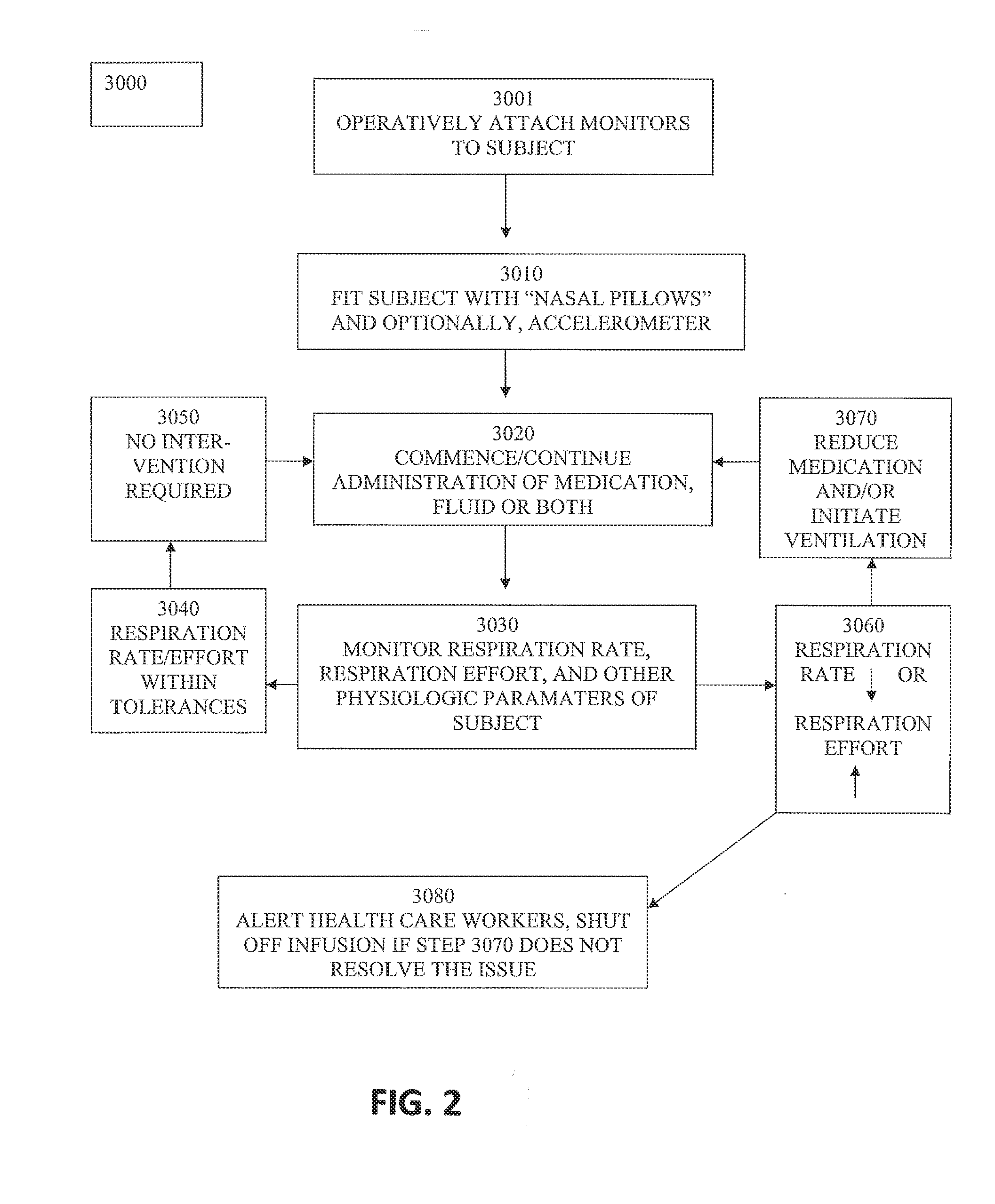Systems And Methods For Using Photoplethysmography In The Administration Of Narcotic Reversal Agents
a technology of narcotic reversal agent and system, applied in the field of system and method for increasing safety in the administration of central nervous system depressants, can solve problems such as pump misprogramming, respiratory depression, and potentially life-threatening conditions, and achieve the effects of improving safety, reducing the risk of respiratory depression, and improving safety
- Summary
- Abstract
- Description
- Claims
- Application Information
AI Technical Summary
Benefits of technology
Problems solved by technology
Method used
Image
Examples
example 1
Deriving Respiratory Parameters from PPG Signals
[0130]A subject was fitted with a nasal photoplethysmography unit and a nasal pressure transducer unit. Raw data from the photoplethysmography (PPG) sensor and the nasal pressure sensor were acquired and processed as described below to derive the subject's heart rate, breath rate, and obstruction level information. These parameters are then used to govern pump titration rate and may be used to determine when to administer a narcotic reversal agent.
DEFINITIONS, ACRONYMS, AND ABBREVIATIONS
[0131]DC=The low frequency component of either the red or infrared channels of the PPG sensor found by subtracting the AC component from the raw signal.
AC=The cardiac or high frequency component of either the red or infrared channels of the PPG sensor
Algorithm Description
[0132]The algorithm can be broken up into three main phases: (2) filtering and preprocessing, whereby streaming data is separated into the channels that will be used in parameter calcul...
example 2
Graphical User Interface of Infusion Monitor
[0165]A closed-loop or open loop system or apparatus may be emplaced on a subject, either by the subject or a colleague, physician, or the like. On being emplaced, the system initiates, conducts an internal self check to ensure that it is operating properly, that it has sufficient power for reliable operation, that it is properly interfaced with the subject and is able to acquire appropriate PD, PK, or PD and PK signals from the subject. The thus emplaced and properly operational system may then be used to monitor the subject or it may go into a sleep or standby mode in which operational parameters are minimized along with minimal power consumption.
[0166]On being stimulated by an appropriate wake-up signal, which may be the subject pressing a start button, or an integrated motion sensor such as an accelerometer recognizing a motion state that is defined as requiring wake-up (e.g., excessive vibration, or no motion at all by the subject, or...
example 3
Detection of Respiratory Events with PPG and PSG
[0177]Polysomnography (PSG) and PPG data was obtained from 35 subjects and scored manually by a trained research technician. The data on the first 20 subjects will be used as a training set, and the data on the remaining 15 subjects used as a validation set. Optionally, a study to collect data on up to 10 subjects with epiglottic catheter as a measure of respiratory effort was included.
[0178]Preliminary assessment of the prototype AHI estimator based on new patient data and analysis / integration of appropriate algorithms and analysis is provided summarizing in-sample data. To determine the accuracy of the SPCDS, RDIs were calculated for each study and compared to manual scoring. Receiver-operator characteristic curves can be constructed for the RDIs calculated to assess the performance of the automated algorithm across the spectrum of SDB severity (RDI cutoffs of 5, 10, 15, 20 and 30 events per hour for defining obstructive sleep apnea)...
PUM
 Login to View More
Login to View More Abstract
Description
Claims
Application Information
 Login to View More
Login to View More - R&D
- Intellectual Property
- Life Sciences
- Materials
- Tech Scout
- Unparalleled Data Quality
- Higher Quality Content
- 60% Fewer Hallucinations
Browse by: Latest US Patents, China's latest patents, Technical Efficacy Thesaurus, Application Domain, Technology Topic, Popular Technical Reports.
© 2025 PatSnap. All rights reserved.Legal|Privacy policy|Modern Slavery Act Transparency Statement|Sitemap|About US| Contact US: help@patsnap.com



